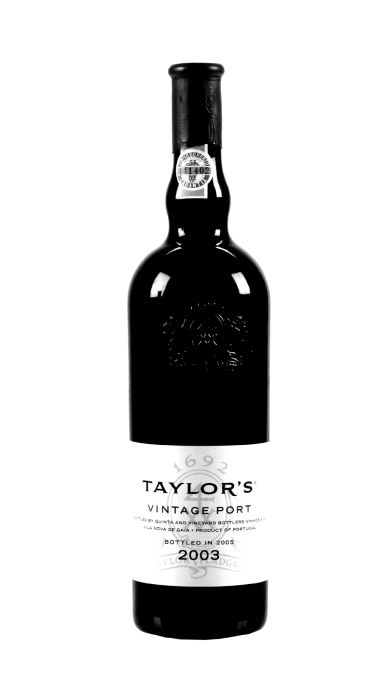Need Help Finding the right wine?
Your personal wine consultant will assist you with buying, managing your collection, investing in wine, entertaining and more.
By continuing, you agree to our privacy policy, consent to cookies, and confirm you are 21 or older.
I have read and agree to the Privacy Policy and Terms of Service.
YOU MUST BE 21 OR OLDER TO CONTINUE
NYC, Long Island and The Hamptons Receive Free Delivery on Orders $300+
Cool Wine Shippers Now Available.
Checkout using your account
Checkout as a new customer
Creating an account has many benefits:

2003 Taylor Fladgate Vintage Port
100 RP-HG
| Type of Wine | Dessert |
|---|---|
| Varietal |
Proprietary Blend
: Proprietary Blend is a general term used to indicate that a wine is comprised of multiple grape varietals which are either “proprietary” to the winery or is blended and does not meet the required maximum or minimum percentage of a particular varietal. This also is the case for the grape’s place of origin, especially for region, appellation or vineyard designated wines. There are endless examples of blended wines which are labeled as “Proprietary Blend” and in conjunction with each region’s stipulated wine laws and regulations makes for a vast blanket for wines to fall into. Perhaps the simplest example is California; if a wine is to be labeled as Napa Valley Cabernet Sauvignon, it is required to have at least 75% of the varietal (Cabernet Sauvignon) and 85% of the fruit must be cultivated from the Napa Valley wine district. If the wine does not meet the requirements, it is then labeled as Proprietary Blend. |
| Country |
Portugal
: Viticulture has existed on the Iberian Peninsula (home to modern day Spain and Portugal) for thousands of years, dating as far back as 2000 BC. The country of Portugal, with its 250 native grape varieties, has a long and colorful history of viticulture and is renowned for its production of the world-famous fortified wines of Port and Madeira. Beyond these rich and intriguing styles, the country has become diversified, and is now being recognized for its refreshing whites of Vinho Verde, sparkling wines from Obidos and the warm reds from Douro and Dao. In the past few decades, Portugal has enjoyed somewhat of a revival in terms of viticulture and is becoming increasingly popular for its many wine styles. Portugal may not compare to neighboring Spain’s production rate, but in terms of quality, it can do more than hold a candle. Portugal’s production of Port is, without a doubt, its fame to claim and has brought global recognition; however Its recent renaissance and its incredible array of wine styles has helped to only bring more attention to the country’s wine industry. Its annual production of 600 million liters of wine from its 195,000 hectares under vine is an incredible feat for one of the smaller wine producing countries. Many of the key grape varieties cultivated in Portugal are considered native. Touriga Nacional, Trincadeira, Baga and Tinta Roriz lead the way and are the most popular and important grapes grown. Portugal’s temperate, predominately maritime climate and portfolio of terroirs is greatly conducive to vinification. Its many mountains, river valleys and limestone-rich coastal hills allows for a rich and diverse range of soils. The Atlantic influences the growing season which sees high levels of rainfall allowing for high yields. This can also be a detriment and an increased risk of fungal diseases. Coastal region winegrowers has have worked diligently to cultivated ventilated sites as well as high trellising methods to keep the grapes from developing bunch rot. The international wine market is becoming more cognizant of the many great wines coming from Portugal, from the reds of Douro and Dao to the red, white and rose from Vinho Verde, sparkling renditions from native varietals to the unprecedented and world-famous Port wines. International varieties (most of French origins) such as Syrah and Merlot have taken root in Portuguese soil. Despite the arrival of these varieties making a splash, and intrigue, Portugal’s long tradition of winemaking in the region has allowed winemakers to maintain a certain uniqueness in their wines. The Old Word nation of Portugal commands global respect and recognition for its many accomplishments and contributions to the world of wine. |
| Region |
Port
: Oporto is the home to the most exceptional Portuguese wines out there. Located on the Atlantic coast, one of the largest cities of Portugal is also one of the most well-regarded wine regions in this European country. At its beginnings, Port wine was more acidic and dry than today. That was due to brandy, which winemakers added to wine to keep it stable before they shipped it to the UK. Later on, brandy was used to capture the sweet ripe grape flavors, which contributed to the maturing potential of Port wines. Vinho do Porto is one of the favorite dessert wines for many, given it's usually irresistibly sweet. However, other varieties are also known to win the hearts of wine enthusiasts all over the world with beautiful whites, and delicious semi-dry reds, whether they're aged in bottles or in barrels. There are more than a hundred different grape varieties in Port, but only five have made it to the top. Tinta Barroca, typical for the Douro region, and Tempranillo, known for its early ripening, are some of the most commonly blended ones. Tempranillo is also famous for its remarkable strawberry and plum hints on the palate. To get to know Port wines, one must not miss out on Taylor Fladgate Vintage Port, or Quinta do Noval Nacional Vintage Port. |
| Subregion | Douro |
| Producer | Taylor Fladgate |
|---|
Need Help Finding the right wine?
Your personal wine consultant will assist you with buying, managing your collection, investing in wine, entertaining and more.